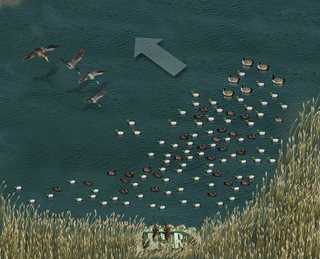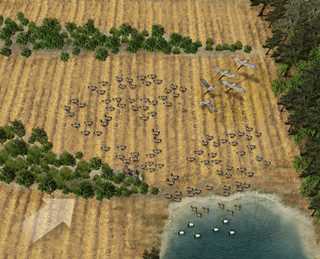Super-Natural Spreads
Create an ultra-realistic decoy spread that imitates the behavior and body language of live waterfowl
Create an ultra-realistic decoy spread that imitates the behavior and body language of live waterfowl

By James Card
In recent years, decoy manufacturers have broken the mold. For decades, plastic decoys were cookie-cutter representations of waterfowl mass-produced from generic plastic molds. They had little resemblance to the classic wooden and cork decoys master carvers once crafted by hand in their workshops. But fortunately for today's waterfowlers, all that has changed.
Many modern plastic decoys, such as Avery's Greenhead Gear (GHG) line, are made from molds created from actual hand-carved decoys produced by contemporary masters. The results are ultra-realisticor as close to the real McCoy as one can get with plastic. In addition, many of these next-generation decoys come with moveable heads and in a variety of attitudes and postures that mimic the behaviors of real waterfowl. This has brought a whole new level of realism to the decoy game, allowing duck and goose hunters to assemble incredibly lifelike spreads that would have been unimaginable a decade ago.
Of course, more realistic decoys can mean more ducks and geese in your game bag, but you have to know how and where to use them for maximum effect. What follows are four waterfowl hunting scenariosfrom four Avery pro-staffersthat will help you incorporate these cutting-edge decoys into your spreads and lure more ducks and geese to your gun.
Field Hudnall of LaGrange, Kentucky, has developed an ultra-realistic big-river decoy spread with a twist. He uses large numbers of goose decoys on the big waters of the Ohio River to bring in ducks as well as geese. "Ducks can see Canada goose decoys from much farther away than duck decoys because they are larger and have more color contrast," he says.
Hudnall's typical big-river rig consists of multiple "pods" of duck and goose decoys set on land and in the water. He uses large numbers of GHG life-size Canada goose floaters in active, feeding, and resting postures. On the outer edge of the spread, he runs a line of active-style floaters about 45 to 50 yards from the blind. Resters and sleepers are positioned in the shallow water just offshore. Directly in front of the blind, in the "kill hole," he places a combination of GHG oversize, surface-feeder, no-head, and butt-up mallard decoys imitating a contented flock of resting and feeding birds. The mass of decoys near the shoreline, along with effective calling, helps pull incoming waterfowl into the landing zone created by the outer wing of decoys. Smaller gaps between groups of decoys offer alternative landing areas.
But Hudnall cautions against placing too many decoys offshore. Instead, he prefers to spread as many decoys as possible along the riverbank upwind of his blind. "If ducks and geese are up on the bank, then surely it's a great place to be. There might be food, they can rest out of the current or wind, and they can get grit," he says.

Photo Kevin Hand
The dry-land component of Hudnall's rig is even more varied than his water set. These decoys include fully flocked (FFD Elite) full-body Canadas in looker, feeder, and active postures, and shells in rester, feeder, and sleeper positions. Groups of GHG oversize full-body mallards round out the spread. All are set on motion stakes to provide lifelike movement in the slightest breeze.
Mike Bard of Jordon, New York, hunts the big waters of the Atlantic Flyway, including Lakes Ontario and Erie, the St. Lawrence River, and the Finger Lakes of New York. Hunting from a layout boat, he mainly targets bluebills and redheads but also takes his share of buffleheads, goldeneyes, canvasbacks, ringnecks, ruddy ducks, common mergansers, and occasionally some sea ducks.
Bard's diver rig consists of 10 to 15 dozen decoys, the majority of which are strung on long lines. Six to 12 decoys are attached to each line. The lines are weighted on both ends. Decoys are grouped tightly together on the upwind end of the lines closest to the boats and farther apart on the downwind end. Individually rigged decoys are placed in front of the boat to beef up the upwind part of the rig.

Photo Kevin Hand
"This spread is replicating a mass of feeding divers," Bard explains. "It's a large, tightly grouped spread with an open lane that is inviting for divers to land in. The downwind string of more loosely spaced decoys replicates birds on the outer edge of the food source swimming in or resting."
GHG oversize and life-size bluebills in low-head and high-head positions along with oversize redheads form the backbone of his spread. When specifically targeting bluebills, he uses six dozen bluebill decoys and two dozen redhead decoys. He reverses this ratio when redheads are the primary quarry. Oversize canvasbacks and redheads are mixed throughout the spread to provide more visibility and color contrast in different light conditions.
Bard's spread also includes oversize goldeneyes and buffleheads, which he sets in groups of three to five decoys. "I like to mix in a line or two of buffleheads or goldeneyes leading right into the feeding mass," he says. "These decoys have a lot of white on them, making them highly visible attractants, especially on sunny days."
Shooting Tip
For right-handed shooters, the bulk of the spread should be set to the left of the layout boats. The opposite goes for lefties.
Ben Fujan of Sioux Falls, South Dakota, specializes in hunting dabbling ducks on marshes in the Prairie Pothole Region. His standard duck spread consists of 75 to 150 floaters. The vast majority of his decoys (80 percent) are GHG life-size mallards in active, sleeper, no-head, rester, and surface-feeder body styles. The rest of his decoys consist of life-size pintails and wigeon and oversize black ducks.
"Most hunters in my area don't use black duck decoys because we seldom see them over here," Fujan says. But their large size and dark color make them highly visible from afar. "I haven't witnessed any problems finishing mallards or other puddle ducks with black duck decoys mixed in with my mallards," he adds.

Photo Kevin Hand
Fujan sets a handful of life-size Canada goose floaters on the periphery of the spread to provide greater visibility and to attract any passing honkers. He also places three or four active-style mallard decoys in the landing zone to look like a small flock has just landed. "Often, when ducks hit the water they stay in the sentry position until they settle down," Fujan says. "I mix the no-head, surface-feeder, and sleeper decoys closest to shore. The birds in the shallower water are more likely to be feeding or sleeping. The deeper the water gets, the more rester and active decoys I use."
With half a million Canada geese wintering in a three-county area, Maryland's storied Eastern Shore has some of the finest goose hunting in the Atlantic Flyway. This historic waterfowling area also has some of the most intense hunting pressure anywhere.
To fool this region's highly educated honkers, Wayne Radcliffe of Chestertown has developed an innovative field rig, which he uses to hunt geese on a plantation established in 1674. "The place I hunt doesn't look like a traditional goose field," Radcliffe says, referring to the field's hedgerows and pond. And that gives him an advantage when geese become more familiar with hunters and their decoy spreads as the season wears on.
The bulk of his rig consists of GHG life-size Canada geese in active and feeder positions. But he also mixes in GHG lesser Canada goose decoys in these same postures. "We have two populations of Canada geese, residents and the Atlantic Population. The Atlantic Population geese are smaller than residents, so adding these smaller decoys to the spread provides more realism," he explains.

Photo Kevin Hand
To further set his decoys apart from competing spreads, he places a dozen life-size rester and sleeper decoys along the edge of the adjacent pond and six Canada goose floaters just offshore. Near the landing zone in front of his blind, he positions several FFD Elite Lookers to appear like birds have just landed. "The landing zone should look like a safe place that gives confidence to incoming geese," Radcliffe says.
For concealment, he uses an A-frame stand-up blind hidden in a dense hedgerow. Decoying geese rarely touch down outside the landing zone, but if any birds veer over the pond, hunters on the right side of the blind can get a shot. And what if any geese touch down on the perimeter of the spread? "They get to live," Radcliffe says. That is his live-and-let-live code for very lucky (or wise) geese.